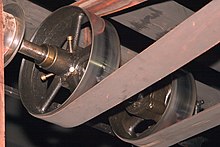Belt (mechanical)
Types of Belts:
- Mechanical belt drive first mentioned in 15 BC by Yang Xiong.
- Belt drive essential for the invention of the spinning wheel.
- Belt drive used in textile and hydraulic-powered bellows technologies.
- Belt drives offer shock absorption and smooth operation.
- Belt engineering advancements allow for use in various systems.
- Flat belts widely used in the 19th and early 20th centuries for power transmission.
- Rope drives outperformed flat belts in the mid-19th century.
- Round belts designed for V-groove pulleys.
- V belts provide traction, speed, load, and long service life.
- Multi-groove belts offer improved efficiency.
- Ribbed belts feature lengthwise grooves for power transmission.
- Film belts are thin belt strips for low-power, high-speed uses.
- Timing belts are positive transfer belts for tracking relative movement.
- Specialty belts transmit power on the tension side of the loop.
Power Transmission:
- Belts are cost-effective for power transmission between non-axially aligned shafts.
- Power transmission achieved through designed belts and pulleys.
- Efficiency of belt drives ranges from 90-98%.
- Different speeds achieved through stepped or tapered pulleys.
- V belts ideal for small center distances and high reduction ratios.
- Multi-groove belts can wrap around any number of driven pulleys.
- Ribbed belts suitable for various applications like compressors and lawn mowers.
- Timing belts used for indexing or timing purposes.
Belt Design and Functionality:
- Flat belts deliver high power at high speeds but require high tension.
- Round belts mainly used in low torque situations.
- V belts have a V shape to prevent slippage.
- Ribbed belts offer even tension distribution and stability.
- Film belts commonly used in business machines and printers.
- Timing belts have teeth for no slippage.
- Specialty belts used in specific applications like rolling roads for wind tunnels.
Belt Maintenance and Performance:
- Excessive friction wastes energy and wears out the belt quickly.
- Proper belt tension is crucial for efficient power transmission.
- Factors like belt tension, speed, and environmental conditions influence belt wear.
- Belt vibration can be caused by various operational conditions.
- Belt dressings increase friction between the belt and the pulleys.
- Belt replacement, retensioning, or dressing can extend the belt’s lifespan.
Standards and Specifications:
- ISO standards cover requirements for power transmission belts.
- DIN standard focuses on belt conveyors in bulk material handling.
- ANSI/RMA standard ensures reliability of elastomeric belts in industrial applications.
- SAE standard specifies automotive V-belts and V-ribbed belts.
- ASTM standard focuses on testing conveyor belts for specific applications.
- Specifications include material, length, cross-section size, and teeth size for timing belts.
A belt is a loop of flexible material used to link two or more rotating shafts mechanically, most often parallel. Belts may be used as a source of motion, to transmit power efficiently or to track relative movement. Belts are looped over pulleys and may have a twist between the pulleys, and the shafts need not be parallel.


In a two pulley system, the belt can either drive the pulleys normally in one direction (the same if on parallel shafts), or the belt may be crossed, so that the direction of the driven shaft is reversed (the opposite direction to the driver if on parallel shafts). The belt drive can also be used to change the speed of rotation, either up or down, by using different sized pulleys.
As a source of motion, a conveyor belt is one application where the belt is adapted to carry a load continuously between two points.
GD Garage Door Service MN • 651-373-0970
